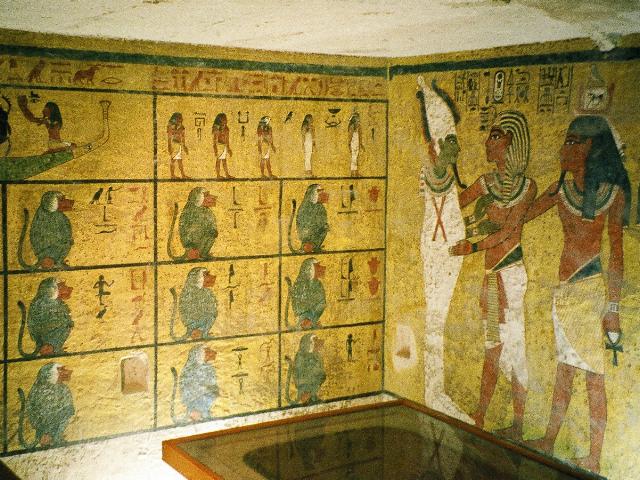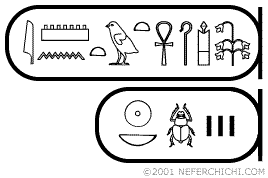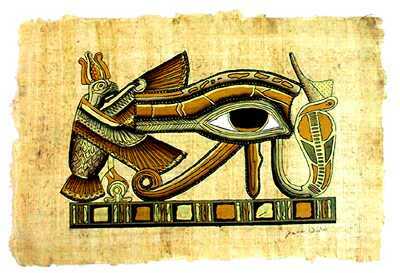Egyptian art changed very little over 3000 years. With the exception of the Armarna Period the style, meaning of colors and body positioning were very uniform in Egyptian paintings. Colors made from mineral compounds have lasted through the ages, their meaning still shining through to this day. Green was the color of new life and growth. Blue symbolized creation and rebirth. Red was the color of power, showing life and victory, as well as anger. Yellow, the color of Ra, showed things to be indestructable and eternal, like the sun and gold. Death was represented with black, which also was a symbol for the underworld and night. White was a sacred color, symbolizing purity and simplicity.

Paintings on the walls of Tutankhamun's tomb
Egyptian art lacks motion, walking being one of the only variations. The position of their bodies is unique to Egytian art, the arms and legs are shown from the side. Usually the head is shown facing forward and the body depicted straight on. Gods or pharaohs generally are displayed slightly bigger than the other figures in the painting, showing their importance.
Image courtesy of: http://en.wikipedia.org/wiki/Tutankhamun

Tutakhamun's cartouche
The cartouche is an oblong circle with a line at one end, it symbolizes that the writing enclosed is a royal name. They first were used in the Fourth dynasty under Pharaoh Sneferu. Heiroglyphics contained both logographic and alphabetic symbols making it a very unique language.
Image courtesy of: http://en.wikipedia.org/wiki/Tutankhamun

The Eye of Ra painted on papyrus
Papyrus paper originates from the plant Cyperus papyrus, it grows plentifully along the Nile. Once papyrus was made into sheets the Egyptians used it as writing material. Often times a scribe wrote only on a single sheet and rolled it up or folded it. In ancient times it was resourceful for things other than paper, for instance it was used to produce boats, rope and baskets.
This image courtesy of: www.natashascafe.com/html/papyrus.html

This painting depicts Semite traders coming to trade eye paint. The painting was found in the tomb of Khnumhotep in Beni Hasan, Middle Egypt.
This image courtesy of: abr.christiananswers.net/articles/article58.html